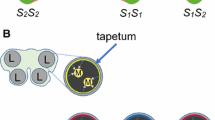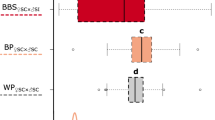Abstract
In crucifers, the pollen S-determinant gene, SP11, is sporophytically expressed in the anther tapetum, and the pollen self-incompatibility phenotype is determined by the dominance relationships between the two S-haplotypes it carries. We report here that 5′ promoter sequences of recessive SP11 alleles are specifically methylated in the tapetum before the initiation of SP11 transcription. These results suggest that tissue-specific monoallelic de novo DNA methylation is involved in determining the dominance interactions that determine the cruciferous self-incompatibility phenotype.

Similar content being viewed by others
References
Shimizu, K.K. et al. Science 306, 2081–2084 (2004).
Brennan, A.C., Harris, S.A. & Hiscock, S.J. Phil. Trans. R. Soc. Lond. B 358, 1047–1050 (2003).
Hatakeyama, K. et al. Heredity 80, 241–247 (1998).
Shiba, H. et al. Plant Cell 14, 491–504 (2002).
Kakizaki, T. et al. Plant Cell Physiol. 44, 70–75 (2003).
Schopfer, C.R., Nasrallah, M.E. & Nasrallah, J.B. Science 286, 1697–1700 (1999).
Frieman, M. et al. Genetics 152, 451–460 (1999).
Chen, Z.J., Comai, L. & Pikaard, C.S. Proc. Natl. Acad. Sci. USA 95, 14891–14896 (1998).
Bird, A. Genes Dev. 16, 6–21 (2002).
Bender, J. Annu. Rev. Plant Biol. 55, 41–68 (2004).
Zhu, W.-G. et al. Mol. Cell. Biol. 23, 4056–4065 (2003).
Boyes, J. & Bird, A. Cell 64, 1123–1134 (1991).
Kim, S.Y., Chung, H.-J. & Thomas, T.L. Plant J. 11, 1237–1251 (1997).
Shiota, K. Cytogenet. Genome Res. 105, 325–334 (2004).
Kinoshita, T. et al. Science 303, 521–523 (2004).
Acknowledgements
We thank J.R. Ecker and B.D. Gregory for critical comments and discussion. We thank H. Ichikawa, T. Ohnishi, N. Wada, T. Ueda, K. Iwasaki, H. Sugita, E. Okamoto and H. Sato for technical assistance. This work was supported in part by Grants-in-Aid from the Japanese Ministry of Education, Culture, Sports, Science and Technology and the Japan Society for Promotion of Science, and the 21st Century COE programs at Nara Institute of Science and Technology and at Iwate University.
Author information
Authors and Affiliations
Corresponding authors
Ethics declarations
Competing interests
The authors declare no competing financial interests.
Supplementary information
Supplementary Fig. 1
Analyses of DNA methylation status at the S-locus region of the S60 haplotype. (PDF 127 kb)
Supplementary Fig. 2
The hypermethylated SP11 promoter region and its requirement for transcriptional activity. (PDF 178 kb)
Supplementary Table 1
Primer sequences. (PDF 74 kb)
Rights and permissions
About this article
Cite this article
Shiba, H., Kakizaki, T., Iwano, M. et al. Dominance relationships between self-incompatibility alleles controlled by DNA methylation. Nat Genet 38, 297–299 (2006). https://doi.org/10.1038/ng1734
Received:
Accepted:
Published:
Issue Date:
DOI: https://doi.org/10.1038/ng1734
- Springer Nature America, Inc.
This article is cited by
-
Ancestral self-compatibility facilitates the establishment of allopolyploids in Brassicaceae
Plant Reproduction (2023)
-
Biotic stress-induced epigenetic changes and transgenerational memory in plants
Biologia (2022)
-
SCR-22 of pollen-dominant S haplotype class is recessive to SCR-44 of pollen-recessive S haplotype class in Brassica rapa
Horticulture Research (2019)
-
Progress on deciphering the molecular aspects of cell-to-cell communication in Brassica self-incompatibility response
3 Biotech (2018)
-
Multilayered dominance hierarchy in plant self-incompatibility
Plant Reproduction (2018)





